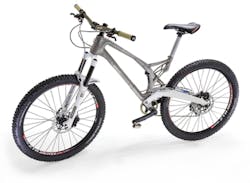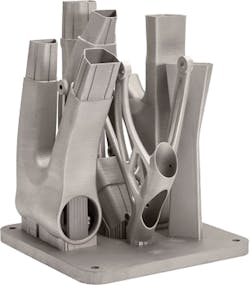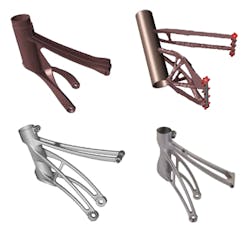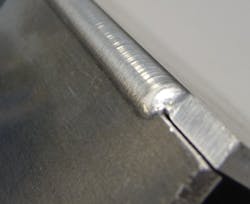Wotton-under-Edge, Gloucestershire, England - Renishaw, the UK's only manufacturer of metal-based additive manufacturing machines, has collaborated with Empire Cycles, a British bicycle company, to create the world's first 3D-printed metal bike frame. Empire designed the mountain bike to be stronger and lighter by using a process called topological optimization and employing Renishaw's AM250 additive manufacturing system.
The additive process offers design, construction, and performance advantages that include: blending complex shapes or hollow structures with internal strengthening features, flexibility to make design improvements right up to the start of production, and the convenience of making one-off parts as easily as batches, which allows for customization. The new titanium-alloy frame, about 33 percent lighter than the original, was manufactured in sections and bonded together.
After successful production of the bike's seat post bracket, improvement of the whole frame became a new goal. Empire started with a full-size 3D-printed replica of its current aluminum-alloy bike and the frame was sectioned into parts that could be formed in the AM250's 12-in. build height. With guidance from Renishaw, an optimized design was created using topological optimization that eliminates many of the downward-facing surfaces that require wasteful support structures.
Topological optimization
Topological optimization software programs use iterative steps and finite element analysis to determine the "logical" material placement. Material is removed from areas of low stress until a design optimized for load bearing is created, resulting in a model that is light and strong. Historical challenges in manufacturing these computer-generated shapes are overcome through the additive manufacturing process.
The AM250 uses a high-power fiber laser to produce fully dense metal parts direct from 3D CAD data. Parts are built layer by layer, in thicknesses ranging from 20 to 100μm, using a range of fine metal powders melted in a tightly controlled atmosphere. A fully welded vacuum chamber and ultra-low oxygen content in the build atmosphere allow processing of reactive materials, including titanium and aluminum.
The key benefit from the additive process is that the design has all of the advantages of a pressed steel "monocoque" construction used in motorbikes and cars, without the investment in tooling that would be prohibitive for a small manufacturer.
Making it light
The original aluminum-alloy seat post bracket is 12 oz. and the first iteration of the hollow titanium version is 7 oz.—a weight savings of 44 percent. Comparison of the entire frame has the original bike frame weighing in at 4.6 lbs, with the redesigned, additive-made frame at only 3.1 lbs.—a 33-percent weight savings.
"There are lighter carbon fiber bikes available, but the durability of carbon fiber can't compare to a metal bike," said Chris Williams, managing director at Empire Cycles. "When you start chucking yourself down a mountain, you risk damaging the frame. We over-engineer our bikes to ensure there are no warranty claims."
Titanium alloys have more density than aluminum alloys; therefore, the only way to make a titanium-alloy part lighter than its aluminum-alloy counterpart is to significantly alter the design and remove any material not contributing to the overall strength of the part. The two companies believe that with further analysis and testing, it could result in further weight reduction.
Making it strong
In addition to durability and corrosion resistance, titanium alloys have a high ultimate tensile strength when processed using additive manufacturing. With near-perfect densities-greater than 99.7 percent—the process is better than casting and the small, spherical nature of additive-part porosity has little negative effect on strength. The seat post bracket was tested using the mountain bike standard EN 14766, and it withstood 50,000 cycles of 270 lb. ft. Testing continued to six times the standard without failure.
Continued improvement through collaboration
Research into bonding methods resulted in Mouldlife (Bury St Edmunds, Suffolk, England) providing the adhesive, which was tested by technical specialists at 3M test facilities. The wheels, drivetrain, and components required to finish the bike were provided by Hope Technology Ltd (Barnoldswick, Lancashire, England).
The two companies plan to continue testing the completed bicycle frame in the laboratory, using Bureau Veritas (Birmingham, England), and in the field, using portable sensors in partnership with Swansea University (Wales).
"We plan to develop this further, in partnership, to look at iterative improvements in bonding methods, such as specific surface finishes," said Bozich. "This project demonstrates that excellent results can be achieved through close customer collaboration."
For further information, visit www.renishaw.com/empire.
Impeccable welding seams in thick-walled aluminum
Gaggenau, Germany - When laser welding aluminum, the weld pool is quite distinctly fluid. Material expulsions and holes can occur, and these permit neither an acceptable weld quality nor good bonding.
Visibly good results can be achieved using a coaxial seam tracking system and the precisely adjustable effective width of the laser spot. Consequently, it is not only thin components-generally the case with conduction welding-that can be welded. However, using the ScanTracker from Precitec KG also permits conduction welding, with scan function, of thick-walled aluminum components. There is no need for expensive and complex post-treatment, above fall for visible seams.
During the welding process, ScanTracker measures the weld joint transversely and the distance in the Z-direction just a few millimeters before the TCP coaxially via the YW52 welding optics. The welding head is fully autonomous and controls the laser spot two-dimensionally and precisely at the joint without additional axes. Minimal lead time under 1/10th of a second and programmable distribution of linear energy across the width of the seam guarantee short cycle times.



